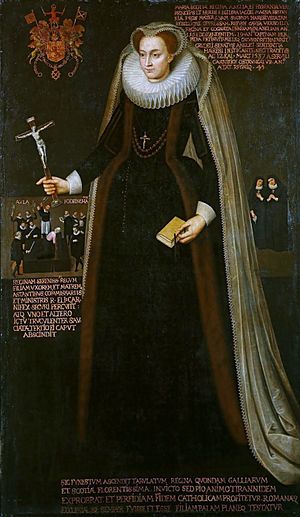Jane Kennedy (courtier) facts for kids
Jane Kennedy (died 1589) was a close companion of Mary, Queen of Scots. She stayed with Mary during her time as a prisoner in England. Jane might have been the daughter of Gilbert Kennedy, 3rd Earl of Cassilis.
Contents
Serving the Queen in Captivity
After the Battle of Carberry Hill, Jane was with Mary at Lochleven Castle. Mary was held there and signed papers giving up her crown. Stories say Jane tried to help Mary escape. Some accounts say she jumped from a wall while practicing. Others say she leaped from a window to join Mary as she fled the island. Jane then helped row the boat to Kinross. These stories were shared by Nicolas Caussin in a book called La Cour Sainte in 1664.
In England, Jane was listed as a "maid" in Queen Mary's household. This was in October 1569 at Tutbury Castle. Her name was written as "Gin Cannate" by a French writer. By 1571, at Sheffield Castle, she was called a "maid of the chamber." The Earl of Shrewsbury wrote about a servant named Martin. He thought Martin was getting too close to "Jane Kenyte, the Scottish queen's woman." Shrewsbury made Martin promise on the Bible to stay away from her.
By 1586, at Chartley Manor, Jane was a "Gentlewoman of the Queen's chamber." She was in charge of Mary's valuable jewels. An inventory was made of the jewels and silver she held. This happened when Mary was moved to Tixall for two weeks and her things were searched. Jane also managed Mary's linen and laundry.
At Fotheringhay Castle, Jane Kennedy and Elizabeth Curle helped Mary onto the scaffold. Jane then tied Mary's blindfold. Mary herself had chosen these two ladies for this important duty. Jane and Elizabeth are shown in the Blairs Memorial Portrait of Mary Queen of Scots. In this painting, Jane holds a white cloth. Another version of this picture is part of the Royal Collection.
Life After Queen Mary
At Queen Mary's funeral on August 1, 1587, her ladies joined the procession. Jane Kennedy was among them.
Jane collected two beds from Mary's belongings. One was for the Duchess of Guise. The other was for Madame de Châlons. She told the Spanish ambassador Bernardino de Mendoza that she had blindfolded Mary at the execution. She said she had a higher birth rank than Elizabeth Curle. Mendoza thought about giving Jane a pension from Spain. He wrote that her ship was forced back to Portsmouth by a storm.
Jane Kennedy returned to Scotland from France in January 1588. She spoke with King James VI for two hours. She told him about Mary's final days and described the execution to his courtiers. King James was very sad and thoughtful that day. He did not eat supper.
Jane married Andrew Melville of Garvock. Garvock is a place near Dunfermline. Andrew was the brother of two well-known diplomats, James Melville of Halhill and Robert Melville. In 1568, Andrew had brought a gold chain to Mary when she was held at Lochleven Castle. Mary had given it to a goldsmith, James Mosman, to make into a necklace. Andrew later became the master of Mary's household in England. Andrew and Jane were given joint care of Mary's remaining jewels and silver. Mary had asked Andrew to take some of her items back to Scotland to her son, King James VI. These items included portraits of her ancestors and a piece of unicorn horn. Andrew Melville was held in England for a short time after Mary's execution. King James VI asked his ambassador Archibald Douglas to help free him. Douglas found that Melville was already free.
The Tragic Ferry Boat Accident
Jane Kennedy and her servant, Susannah Kirkcaldy, drowned on September 7 or 8, 1589. They were crossing the river Forth between Burntisland and Leith. The Melvilles owned Rossend Castle in Burntisland. The ferry boat was "midway under sail" when a strong storm hit. The storm pushed the boat with great force into another ship that was also sailing. The ferry boat sank right away. Jane had been called by King James VI. She was meant to wait for the arrival of Anne of Denmark, who was expected at Leith.
The ferry boat sank after hitting another vessel during the storm. The sailors of the other boat, William Downie, Robert Linkhop, and John Watson of Leith, were put on trial. This was in January 1590, for the deaths of sixty passengers. The result of their trial is not known.
The loss of the ferry boat in stormy weather, with almost everyone on board lost, was later blamed on witchcraft. The next year, people from North Berwick were forced to confess to causing the storms. They also accused Francis Stewart, Earl of Bothwell. According to a report from the witch trials called Newes from Scotland, a woman named Agnes Sampson confessed. She said she caused the storm by throwing a dead cat into the sea near Leith.
In Fiction
In Friedrich Schiller's play Maria Stuart, Jane is shown as Mary's nurse. Her name in the play is "Hanna Kennedy." Andrew Melville is called "Melvil."


